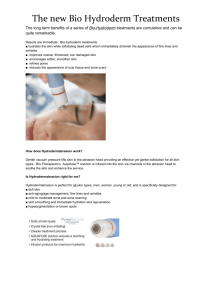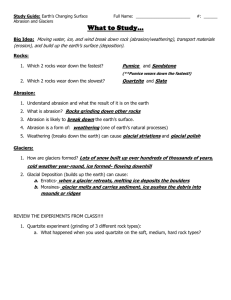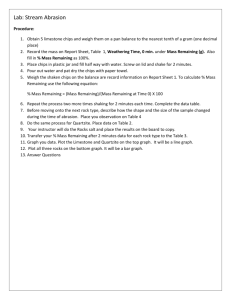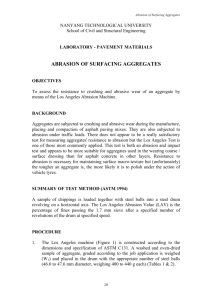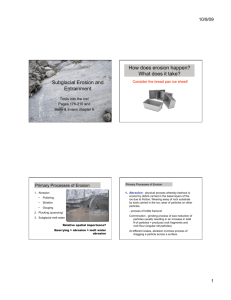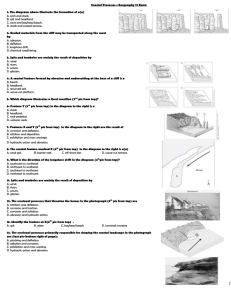case, the coating, which covers the textile coefficient of friction.
advertisement
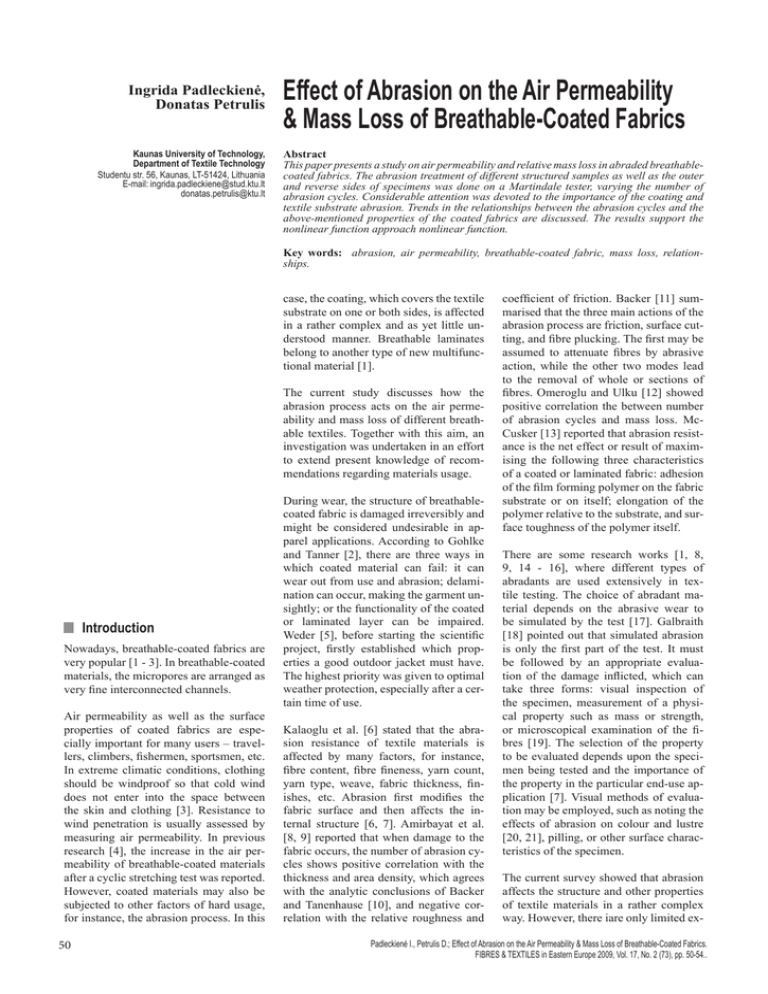
Ingrida Padleckienė, Donatas Petrulis Kaunas University of Technology, Department of Textile Technology Studentu str. 56, Kaunas, LT-51424, Lithuania E-mail: ingrida.padleckiene@stud.ktu.lt donatas.petrulis@ktu.lt Effect of Abrasion on the Air Permeability & Mass Loss of Breathable-Coated Fabrics Abstract This paper presents a study on air permeability and relative mass loss in abraded breathablecoated fabrics. The abrasion treatment of different structured samples as well as the outer and reverse sides of specimens was done on a Martindale tester, varying the number of abrasion cycles. Considerable attention was devoted to the importance of the coating and textile substrate abrasion. Trends in the relationships between the abrasion cycles and the above-mentioned properties of the coated fabrics are discussed. The results support the nonlinear function approach nonlinear function. Key words: abrasion, air permeability, breathable-coated fabric, mass loss, relationships. case, the coating, which covers the textile substrate on one or both sides, is affected in a rather complex and as yet little understood manner. Breathable laminates belong to another type of new multifunctional material [1]. The current study discusses how the abrasion process acts on the air permeability and mass loss of different breathable textiles. Together with this aim, an investigation was undertaken in an effort to extend present knowledge of recommendations regarding materials usage. n Introduction Nowadays, breathable-coated fabrics are very popular [1 - 3]. In breathable-coated materials, the micropores are arranged as very fine interconnected channels. Air permeability as well as the surface properties of coated fabrics are especially important for many users – travellers, climbers, fishermen, sportsmen, etc. In extreme climatic conditions, clothing should be windproof so that cold wind does not enter into the space between the skin and clothing [3]. Resistance to wind penetration is usually assessed by measuring air permeability. In previous research [4], the increase in the air permeability of breathable-coated materials after a cyclic stretching test was reported. However, coated materials may also be subjected to other factors of hard usage, for instance, the abrasion process. In this 50 During wear, the structure of breathablecoated fabric is damaged irreversibly and might be considered undesirable in apparel applications. According to Gohlke and Tanner [2], there are three ways in which coated material can fail: it can wear out from use and abrasion; delamination can occur, making the garment unsightly; or the functionality of the coated or laminated layer can be impaired. Weder [5], before starting the scientific project, firstly established which properties a good outdoor jacket must have. The highest priority was given to optimal weather protection, especially after a certain time of use. Kalaoglu et al. [6] stated that the abrasion resistance of textile materials is affected by many factors, for instance, fibre content, fibre fineness, yarn count, yarn type, weave, fabric thickness, finishes, etc. Abrasion first modifies the fabric surface and then affects the internal structure [6, 7]. Amirbayat et al. [8, 9] reported that when damage to the fabric occurs, the number of abrasion cycles shows positive correlation with the thickness and area density, which agrees with the analytic conclusions of Backer and Tanenhause [10], and negative correlation with the relative roughness and coefficient of friction. Backer [11] summarised that the three main actions of the abrasion process are friction, surface cutting, and fibre plucking. The first may be assumed to attenuate fibres by abrasive action, while the other two modes lead to the removal of whole or sections of fibres. Omeroglu and Ulku [12] showed positive correlation the between number of abrasion cycles and mass loss. McCusker [13] reported that abrasion resistance is the net effect or result of maximising the following three characteristics of a coated or laminated fabric: adhesion of the film forming polymer on the fabric substrate or on itself; elongation of the polymer relative to the substrate, and surface toughness of the polymer itself. There are some research works [1, 8, 9, 14 - 16], where different types of abradants are used extensively in textile testing. The choice of abradant material depends on the abrasive wear to be simulated by the test [17]. Galbraith [18] pointed out that simulated abrasion is only the first part of the test. It must be followed by an appropriate evaluation of the damage inflicted, which can take three forms: visual inspection of the specimen, measurement of a physical property such as mass or strength, or microscopical examination of the fibres [19]. The selection of the property to be evaluated depends upon the specimen being tested and the importance of the property in the particular end-use application [7]. Visual methods of evaluation may be employed, such as noting the effects of abrasion on colour and lustre [20, 21], pilling, or other surface characteristics of the specimen. The current survey showed that abrasion affects the structure and other properties of textile materials in a rather complex way. However, there iare only limited ex- Padleckienė I., Petrulis D.; Effect of Abrasion on the Air Permeability & Mass Loss of Breathable-Coated Fabrics. FIBRES & TEXTILES in Eastern Europe 2009, Vol. 17, No. 2 (73), pp. 50-54.. ured using an L14DR air permeability tester (Karl Schroder KG, Germany), and, as specified in the standard [22], at a pressure drop of 200 Pa. Figure 1. Schematic structure of samples A and B (a) and sample C (b); 1 - outer woven fabric, 2 – coating or laminate, 3 – knitted lining. Table 1. Characteristics of the breathable-coated fabrics; PES - polyester, PA - polyamide, PU – polyurethane. Characteristic Composition of woven fabric, % Composition of knitted fabric, % Material for coating or membrane Weave Tricot structure To determine the mass loss, the cut samples were weighted by means of an EW 150-3M electronic balance (Kern & Sohn GmbH, Germany) at the beginning and after a certain number of abrasion cycles. At the initial stage, the absolute mass loss values in mg were determined: Dm = M1 - M2 Fabric code A Cotton, 23 / PES, 77 - B C PA, 100 PES, 100 - PES, 100 PU PU PU Plain Plain Plain Single jersey - - Mass per unit area, g/m2 194 105 262 Thickness, mm Density of woven fabric, cm-1 warp weft Density of knitted fabric, cm-1 courses wales 0.35 0.14 0.76 43.0 22.5 38.3 33.3 33.3 22.5 - - 6.7 6.7 perimental data to understand the abrasion kinetics of coated textile materials and especially of breathable-coated fabrics. In the current work, the effect of different duration abrasion treatments on the air permeability and mass loss of breathable-coated fabrics was explored, and the abrasion process was studied by applying appropriate models. n Experimental Tests were performed on three different samples of breathable-covered fabrics, the schematic views of which are shown in Figure 1. Two cotton/polyester (PES) and polyamide (PA) woven samples were coated with breathable polyurethane (PU) coating (Figure 1.a), and the third one was a three–ply breathable laminated fabric (Figure 1.b) made from an outer PES woven fabric, an inner PU membrane and knitted PES lining. The characteristics of the materials investigated are given in Table 1. Abrasion tests of the breathable-coated fabric samples were performed on a Martindale Abrasion and Pilling Tester, Code 2561B (SDL ATLAS, England), in accordance with the standard [21]. Conventional wool abradant fabric was used. The pressure imposed on the fabric during FIBRES & TEXTILES in Eastern Europe 2009, Vol. 17, No. 2 (73) rubbing was 12 kPa, as indicated for outdoor applications. Quadratic specimens, each measuring 180 mm × 180 mm, were mounted on the abrasion machine according to method 2 of the standard [21]. Separate specimens were abraded and studied for each side of the sample. To show the abrasion kinetics at various stages, the number of cycles differed widely, ranging from rather low values to large values. Three different abrasion rates (50,000, 60,000, and 70,000 cycles) were used for the outer sideexternal surface of each fabric. Three other different abrasion rates (1,500, 2,500, and 3,000 cycles) were applied to the reverse side of samples A and B. Values of 20,000, 25,000, and 70,000 cycles were selected for the reverse side of sample C as it had a knitted lining on the reverse side, and for that reason the abrasion resistance was much better than of that of samples A and B. In addition, several abrasion rates were applied for experimental verification. Since the abrasive power of most abradants decreases with use [7], a new abradant fabric of standard structure [21] was used for each test. Determination of abrasion damage was based on the change in air permeability and mass of the abraded coated fabric. The air permeability of each specimen before and after full relaxation, not less than 24 hours after abrasion, was meas- (1) where: Δm - absolute mass loss value, M1 - mass of specimen at the beginning of the abrasion test, M2 - mass of specimen at the end of the abrasion test. The relative movement between the abradant and the specimen forms a complex cyclic pattern, i.e. a Lissajous figure (see Figure 2), which produces rubbing in all directions. Since the dimensions of the abraded area, 90 mm × 90 mm, and the area of the above-mentioned specimen are different, the relative mass loss values in % of the abraded samples were additionally computed: δm = (M 1 − M 2 ) ⋅ b 2 M1 ⋅ a2 ⋅ 100% (2) where: δm – relative mass loss value, a - side of abraded area, b - side of specimen. The fabrics were conditioned at a temperature and relative humidity of 20 ± 2 °C and 65 ± 2%, respectively. Regression analysis was made using a Microsoft Excel Analysis Tool Pak. n Results and discussion At one stage of the current study, we attempted to show the kinetics of the air Figure 2. Location and parameters of the abraded area on the sample: a – side of abraded area, b – side of specimen area. 51 Figure 3. SEM views of the reverse side of sample A: (a) initial, (b) after 1500 abrasion cycles. permeability of breathable-coated fabrics during abrasion. The change in air permeability after different abrasion rates and for different abraded sides of the specimens was studied by applying dependencies in the form of regression equations. These dependencies are sketched as graphs in Figures 3 - 6 (see page 53), and the corresponding equations with coefficients of determination are given in Table 2. The main trends regarding changes in the air permeability are discussed below. At the beginning of the abrasion test, the air permeability of each sample was zero, therefore the zero value was assessed and evaluated when performing the regression analysis (see Figures 4 - 6) (see page 53). Thus, the current result is in line with previous air permeability studies of various coated materials [23 - 25]. Further abrasion is related to the initial destruction of the fabric surface (coated or without coating). After a certain number of cycles, we compared changes in the abraded areas of the surface of the reverse side of the sample after a certain number of cycles with those of initial states. An example of the initial view of the reverse side of sample A and the view of the same sample after 1500 abrasion cycles (Figure 3) show a distinct change in the appearance of the coating surface. At this stage, the unevenness of the coated surface was diminished. Corresponding changes in the appearance of the coated surfaces after each abrasion level were also observed. For instance, the matted coating of sample B became lustrous, whereas on the outer side external surface of sample B, no distinct change was noticed. This abrasion damage to the specimens led to the first fluctuations in air permeability. Finally, the abrasion considerably deteriorated the functionality of the materials because a part of the coating and surfaces of the fibres had been worn. At the end of the abrasion test, i.e. after 3000 cycles, the air permeability of the different samples after the abrasion of the reverse side was reported to be about 50-130 dm3/(m2s), whereas the air permeability after the abrasion of the outer Figure 4. Dependence of air permeability on the number of abrasion cycles when abrading the outer side of the samples: and —— sample A; ■ and — — sample B; ▲ and – – – sample C; ◊, □, Δ – values for experimental verification. 52 side fluctuated in the range of about 5090 dm3/(m2s). Since the number of abrasion cycles in the outer side treatment was very great, i.e. 70000, the last range of air permeability may be described as rather small. Thus, the direct abrasion of the microporous cover had a far greater effect than the abrasion of the outer side. For instance, Figure 4 reveals that the abrasion of a side without the cover of samples A and B has a smaller effect on the air permeability if compared with that of direct treatment of coating, as shown in Figure 5. Obviously, the last trend corresponds to statements [26] about the relatively low resistance to abrasion of PU-coated fabrics. Furthermore, we can conclude that the air permeability of the coated materials tested mostly depends on the mechanical destruction of the coating. However, Figure 6 shows a lesser abrasion effect on the air permeability of sample C compared with that of samples A and B, shown in Figure 5. The current trend is connected with the unique construction of sample C. In this sample the knitted lining protects the breathable PU membrane from abrasion damage to the reverse side. As can be seen from Figures 4 & 6, where the air permeability of sample C is given, the outer layer prevents damage better than the back layer. In this case, at the end of abrasion test, the values of air permeability showed a difference of about 20%. This aspect needs further exploratory studies, but presumably the behaviour may be conditioned by different types of adhesion between the membrane and woven layer, as well as between the membrane and knitted layer. As can be seen from Table 2, for all the samples, dependencies in the form of second order polynomial regression equations of have been Figure 5. Dependence of air permeability on the number of abrasion cycles when abrading the reverse side of the samples: and —— sample A; ■ and — — sample B; ◊, □ – values for experimental verification. FIBRES & TEXTILES in Eastern Europe 2009, Vol. 17, No. 2 (73) Figure 6. Dependence of air permeability on the number of abrasion cycles when abrading the reverse side of sample C; Δ – value for experimental verification. Figure 7. Dependence of mass loss on the number of abrasion cycles when abrading the outer side of the samples: and —— sample A; ■ and — — sample B; ▲ and – – – sample C; ◊, □, Δ – values for experimental verification. Figure 8. Dependence of mass loss on the number of abrasion cycles when abrading the reverse side of the samples: and —— sample A; ■ and — — sample B; ◊, □, – values for experimental verification. Figure 9. Dependence of mass loss on the number of abrasion cycles when abrading the reverse side of sample C; Δ – value for experimental verification. suggested for the above-mentioned study of air permeability. The coefficients of determination (0.99) of all six equations showed strong relationships between the number of abrasion cycles and the values of air permeability. At another stage of the research, the mass loss of the same materials after abrasion treatment was studied. The phenomenon of mass loss during the abrasion test of the coated materials reveals how the cutting of the coated surface cutting and the plucking of fibres tend to take place. The process began with initial abrasion, for which the mass loss started from zero (see Figures 7 - 9). Therefore, this value was also applied as the initial level for the study of mass loss kinetics. After the removal of surface unevenness, more intensive abrasion damage was observed. A substantial part of the coating as well as outer fibres were abraded away from the surface. That is why the masses of the specimens at the end of the test were less FIBRES & TEXTILES in Eastern Europe 2009, Vol. 17, No. 2 (73) compared with those at the beginning of the test; therefore we can conclude that the kinetics is connected with a certain rise in relative mass loss. As shown in Figures 7 - 9, in the case of external surface abrasion, the relative mass loss ranged between 1.7 % and 5.4 %, and in the case of reverse side abrasion, this index fluctuated between 2.6 % and 10.4%. As in a previous study on air permeability, direct comparison of these values is not correct because the ranges of the number of abrasion cycles are different. However, since the number of abrasion cycles was very large during testing of the external surface, we can affirm that the textile substrate was far more retardant to abrasion than the coating layer. As can be seen from Figure 8, the abrasion test of the reverse side of samples A and B gives a remarkably higher mass loss compared with the test of the external surface, as shown in Figure 7. Thus, the PU cover appeared more sensitive to abrasion than the conventional textile layer, whereas sample C, with a breathable PU membrane inside the laminated Table 2. Polynomial regression equations and correlation between the number of abrasion cycles and air permeability; Q – air permeability, n – number of abrasion cycles. Abraded side of sample Code of sample Polynomial regression equation Coefficient of determination A Q= -1.306E-08n2 + 2.213E-03n 0.99 Outer side B Q= -1.164E-08n2 + 1.609E-03n 0.99 C Q= -1.326E-08n2 + 2.016E-03n 0.99 A Q= -1.077E-05n2 + 7.353E-02n 0.99 B Q= -7.175E-06n2 + 3.878E-02n 0.99 C Q= -2.695E-08n2 + 3.296E-03n 0.99 Back side 53 Table 3. Polynomial regression equations and correlation between the number of abrasion cycles and relative mass loss; δm – relative mass loss, n – number of abrasion cycles. Abraded side of sample Code of sample Outer side Back side Polynomial regression equation Coefficient of determination A δm= 1.818E-10n2 + 1.137E-05n 0.99 B δm= -4.032E-10n2 + 1.047E-04n 0.99 C δm= 3.140E-11n2 + 6.891E-05n 0.99 A δm= 9.972E-07n2 – 2.739E-04n 0.98 B δm= 1.323E-06n2 – 5.847E-04n 0.97 C δm= 2.521E-10n2 + 1.902E-05n 0.99 fabric, exhibited relatively low mass loss values (see Figures 7 and 9) after the abrasion of each side. Table 3, in which the results of regression analysis for relative mass loss are summarised, shows that, as in the previously mentioned case regarding the air permeability index, second order polynomial regression equations may also be applied. The coefficients of determination varied in the range of 0.97 - 0.99, i.e. strong relationships between the number of abrasion cycles and the values of relative mass loss were observed. Judging from the points of experimental verification, which are additionally given in Figures 4 - 9, it seems that the experimental values are in rather good agreement with the equations. n Conclusions In this work, the effect of abrasion treatment on the air permeability and mass loss of different fabrics with a breathable PU coating was studied. The indices of air permeability and relative mass loss were suggested as estimators of the surface and structural abrasion degradation of breathable-covered fabrics. These values depend mostly on the mechanical destruction of the microporous PU coating layer. However, the textile layers were far more retardant to treatment, i.e. the abrasion of a side without a cover has smaller effect on the air permeability and mass loss compared with that of different treatments of a side covered by breathable PU coating. The least contrast of the abrasion effect for different sides of the specimens was observed for the laminated sample in which the PU membrane had been inserted between two textile layers. Therefore, from a practical point of view, a laminated breathable structure may be recommended for usage conditions of bilateral abrasion, whereas single-sided coated sam- 54 ples are not advisable in this case. To represent abrasion damage to breathable-coated fabrics in relation to the number of abrasion cycles, second order polynomial regression equations have been proposed. The values of air permeability and relative mass loss of the materials tested tended to increase nonlinearly with an increase in the number of abrasion cycles. The coefficient of determination between the number of abrasion cycles and the indices tested varied in the range of 0.97-0.99. References 1. Padleckienė I., Petrulis D.; Types of Multifunctional Breathable Waterproof Fabrics, Usage Perspectives and Problems of Investigations. Proceedings of Conference, Technology and Design of Garments, 2008, 44-48. 2. Gohlke D. J., Tanner J. C.; Gore-Tex Waterproof Breathable Laminates. Journal of Industrial Textiles, 1976, 6, 28-38. 3. Sen A. K.; Coated Textiles: Principles and Applications, Taylor & Francis Group, 2001. 4. Padleckienė I., Petrulis D.; Influence of Mechanical Treatment on Air Permeability of Fabrics with Polymeric Covers. Proceedings of Baltic Polymer Symposium 2007, 2007, 232-236. 5. Weder M.; Performance of Breathable Rainwear Materials with Respect to Protection, Physiology, Durability, and Ecology. Journal of Industrial Textiles, 1997, 27, 146-168. 6. Kalaoglu F., Onder E., Ozipek B.; Influence of Varying Structural Parameters on Abrasion Characteristics of 50/50 Wool/ Polyester Blended Fabric. Textile Research Journal, 2003, 73, 980-984. 7. McNally J. P., McCord F. A.; Cotton Quality Study: V: Resistance to Abrasion. Textile Research Journal, 1960, 30, 715-751. 8. Amirbayat J., Bozzalta G.; Surface Attrition of Worsted Fabrics. Journal of Industrial Textiles, 1995, 65, 760-764. 9. Amirbayat J., Cooke W. D.; Change in Surface Properties of Fabrics during Wear. Textile Research Journal, 1989, 59, 469-477. 10. Backer S., Tanenhaus S. J.; The Relationship between the Structural Geometry of a Textile Fabric and Its Physical Properties: Part III: Textile Geometry and Abrasion-Resistance. Textile Research Journal, 1951, 21, 635-654. 11. Backer S.; The Relationship between the Structural Geometry of a Textile Fabric and Its Physical Properties: Part II: The Mechanics of Fabric Abrasion. Textile Research Journal, 1951, 21, 453-468. 12. Omeroglu S., Ulku S.; An Investigation about Tensile Strength, Pilling and Abrasion Properties of Woven Fabrics Made from Conventional and Compact RingSpun Yarns. Fibres & Textiles in Eastern Europe 2007, 15 (1), 39-42. 13. McCusker J. H.; Some Considerations in Determining Abrasion Resistance of Coated Fabrics. Journal of Industrial Textiles, 1976, 6, 91-94. 14. Stoll R. G.; An Improved Multipurpose Abrasion Tester and Its Application for the Evaluation of the Wear Resistance of Textiles. Textile Research Journal, 1949, 19, 394-415. 15. Willkinson M.; A Review of Industrial Coated Fabric Substrates. Journal of Industrial Textiles, 1996, 26, 87-106. 16. Ceven E. K., Ozdemir O.; Evaluation of Chenille Yarn Abrasion Behavior with Abrasion Tests and Image Analysis. Textile Research Journal, 2006, 76, 315-321. 17. Annis P. A., Bresee R. R.; An Abrasion Machine for Evaluating Single Fiber Transfer. Textile Research Journal, 1990, 60, 541-548. 18. Galbraith R. L.; Abrasion of Textile Surfaces, in “Surface Characteristics of Fibers and Textiles”. Part I, ch. 5., Ed. M.J. Schick, Marcel Dekker Inc., New York, 1975. 19. Lamb G. E. R.; Studies of Fabric Wear: Part I: Attrition of Cotton Fabrics. Textile Research Journal, 1989, 59, 61-65. 20. Alpay H. R., Becerir B., Akgun M.; Assessment of Reflectance and Color Differences of Wool Fabrics after Abrasion. Textile Research Journal, 2005, 75, 607-615. 21. International Standard ISO 5470-2. 22. International Standard ISO 9237. 23. Holmes D.A.; Waterproof Breathable Fabrics. In ‘‘Handbook of Technical Textiles’’. Ed. A.R. Horrocks, S.C. Anand, Woodhead Publishing Limited, Cambridge, 2000. 24. Šulienė O., Urbelis V.; Air Permeability and Resistance to Water of Raincoat Fabrics. Proceedings of Conference, Technology and Design of Garments, 2008, 131-134. 25. Padleckienė I., Petrulis D.; The Change of Air Permeability and Structure of Breathable-Coated Textile Materials after Cyclic Stretching. Materials Science (Medžiagotyra), 2008, 14, 162-165. 26. Morley D.J.; Polyurethane Coated Upholstery Fabrics – Faults that can occur. Journal of Industrial Textiles, 1974, 3, 220-224. Received 17.07.2008 Reviewed 18.11.2008 FIBRES & TEXTILES in Eastern Europe 2009, Vol. 17, No. 2 (73)
